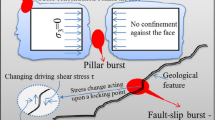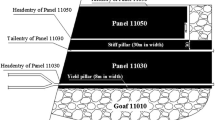Abstract
A wide range of alternatives is available to design a support system to stabilize an underground opening under squeezing conditions. An underground mine development was selected for the research where the underground openings reach to a depth of 1000 m and weak geological formations are present. The operational concerns in the mine development led to a shaft support design having a thick reinforced concrete with very high early strength while the decline was supported by a traditional support system in the squeezing ground. The rigid support in the shaft was typically capable of sustaining high ground pressure and stabilized the opening within negligible radial displacements. It should be noted that the design of the rigid system was straightforward and high early strength concrete had key importance in this case, however, it could only be applied in the shaft. The traditional support system for the decline was a light and conventional system, consisting of thin shotcrete layer, cable bolts and steel arches suffered excessive deformation as high as 60 cm or more. A light-flexible support system with a radial gap was developed for the decline in the same geological unit, allowed substantial ground deformation to occur in a controlled manner, eventually, the opening was stabilized. The newly adopted radial gap allowed improved ground relaxation and reduction of the ground pressure acting on the secondary support layer. The design and application of the yielding support system with a radial deformation gap was effortful, hence the system can be used where available equipment and operational factors force practitioner to use a light and flexible system. The significance of the new system arises from keeping the ground support elements and the operation cycle the same while modifying the support design and installation procedure.
Similar content being viewed by others
References
Barla G (2001) Tunnelling under squeezing rock conditions. Eurosummer-school in tunnel mechanics, Innsbruck, pp 169–268
Barla G, Bonini M, Semeraro M (2011) Analysis of the behaviour of a yield-control support system in squeezing rock. Tunn Undergr Space Technol 26(1):146–154
Barton N, Lien R, Lunde J (1974) Engineering classification of rock masses for the design of tunnel support. Rock Mech 6(4):189–236
Bernard SE (1998) Flexural behaviour in square steel fibre reinforced concrete slabs. In: Proceedings of CONSEC’98 conference, Tromso, Norway
Bieniawski Z (1989) Engineering rock mass classifications. Wiley, New York
Brinkmann and Feist (1970) Soma dağlarının jeolojisi. Bull Miner Res Explor 74(74) (in Turkish)
Cantieni L, Anagnostou G (2009) The interaction between yielding supports and squeezing ground. Tunn Undergr Space Technol 24(3):309–322
Cao C, Shi C, Lei M, Yang W, Liu J (2018) Squeezing failure of tunnels: a case study. Tunn Undergr Space Technol 77:188–203
Carranza-Torres C (2004) Elasto-plastic solution of tunnel problems using the generalized form of the Hoek–Brown failure criterion. Int J Rock Mech Min Sci 41(SUPPL. 1):1–11
Cengiz O, Turanli L (2004) Comparative evaluation of steel mesh, steel fibre and high-performance polypropylene fibre reinforced shotcrete in panel test. Cem Concr Res 34(8):1357–1364
European Federation of Producers and Applications of Specialist Products for Structures (1996) European specification for sprayed concrete, EFNARC, Loughborough University, pp 8–10
Goel RK, Jethwa JL, Paithankar AG (1995) Indian experiences with Q and RMR systems. Tunn Undergr Space Technol 10(1):97–109
Guan K, Zhu W, Wei J, Liu X, Niu L, Wang X (2018) A finite strain numerical procedure for a circular tunnel in strain-softening rock mass with large deformation. Int J Rock Mech Min Sci 112:266–280
Hoek E (2001) Big tunnels in bad rock. J Geotech Geoenviron Eng 127(9):726–740
Hoek E (2007) Practical rock engineering—chapter 12: Tunnels in weak rock
Hoek E, Diederichs MS (2006) Empirical estimation of rock mass modulus. Int J Rock Mech Min Sci 43(2):203–215
Hoek E, Carranza-Torres C, Corkum B (2002) Hoek-Brown failure criterion-2002 edition. Proc NARMS-Tac 1(1):267–273
Høien AH, Nilsen B, Olsson R (2019) Main aspects of deformation and rock support in Norwegian road tunnels. Tunn Undergr Space Technol 86:262–278
Jimenez R, Recio D (2011) A linear classifier for probabilistic prediction of squeezing conditions in Himalayan tunnels. Eng Geol 121(3–4):101–109
Kahraman S, Aloglu AS, Aydin B, Saygin E (2019) The needle penetration index to estimate the performance of an axial type roadheader used in a coal mine. Geomech Geophys Geo-Energy Geo-Resour 5(1):37–45
Kirsten HAD (1993) Equivalence of mesh-and fibre-reinforced shotcrete at large deflections. Can Geotech J 30(3):418–440
Lowson AR, Bieniawski ZT (2013) Critical assessment of RMR based tunnel design practices: a practical engineer’s approach. In: Proceedings of the SME, Rapid excavation and tunnelling conference, Washington, DC, USA, pp 23–26
Maden Tetkik Arama Genel Müdürlüğü (General Directorate of Mineral Research and Exploration), Earth Sciences Map Viewer and drawing tool. Website: https://yerbilimleri.mta.gov.tr/anasayfa.aspx Online acces: 12.05.2020
Majumder D, Viladkar MN, Singh M (2017) A multiple-graph technique for preliminary assessment of ground conditions for tunneling. Int J Rock Mech Min Sci 100:278–286
Mezger F, Ramoni M, Anagnostou G, Dimitrakopoulos A, Meystre N (2017) Evaluation of higher capacity segmental lining systems when tunnelling in squeezing rock. Tunn Undergr Space Technol 65:200–214
Mezger F, Ramoni M, Anagnostou G (2018) Options for deformable segmental lining systems for tunnelling in squeezing rock. Tunn Undergr Space Technol 76:64–75
Nebert K (1978) Lignite-bearing Soma Neogene area, western Turkey. Bull Direct Min Res Explor 90:20–70
Öge İF (2017) Prediction of cementitious grout take for a mine shaft permeation by adaptive neuro-fuzzy inference system and multiple regression. Eng Geol 228:238–248
Öge İF (2018) Prediction of top coal cavability character of a deep coal mine by empirical and numerical methods. J Min Sci 54(5):793–803
Öge İF, Yazar R, Yazar MA, Hür A, Tarhan Ş, Göle M (2019) The implementation of a multi-layer support system in an excessively deformed roadway. In: Proceedings of International Mining Congress and Exhibition of Turkey, 16–19 April 2019, Antalya/Turkey, pp 239–246
Perera MSA, Ranjith PG, Choi SK, Bouazza A, Kodikara J, Airey D (2011) A review of coal properties pertinent to carbon dioxide sequestration in coal seams: with special reference to Victorian brown coals. Environ Earth Sci 64(1):223–235
Rocscience Inc., Phase2 Software v.8.0, (2011).
Shen B (2014) Coal mine roadway stability in soft rock: a case study. Rock Mech Rock Eng 47(6):2225–2238
Stacey TR, OrtIepp WD, Kirsten HAD (1995) Energy-absorbing capacity of reinforced shotcrete, with reference to the containment of rockburst damage. J South Afr Inst Min Metall 95(3):137–140
Stille H, Palmström A (2008) Ground behaviour and rock mass composition in underground excavations. Tunn Undergr Space Technol 23(1):46–64
Tian H, Chen W, Yang D, Wu G, Tan X (2016) Numerical analysis on the interaction of shotcrete liner with rock for yielding supports. Tunn Undergr Space Technol 54:20–28
Ulusay R, Hudson JA (2007) The Blue Book-The complete ISRM suggested methods for rock characterization, testing and monitoring: 1974–2006. ISRM and Turkish National Group of ISRM, Ankara
Vishwakarma AK, Behera T, Rai R et al (2020) Impact assessment of coal mining induced subsidence on native soil of South Eastern Coal Fields: India. Geomech Geophys Geo-energ Geo-resour 6:31. https://doi.org/10.1007/s40948-020-00156-y
Vlachopoulos N, Diederichs MS (2009) Improved longitudinal displacement profiles for convergence confinement analysis of deep tunnels. Rock Mech Rock Eng 42(2):131–146
Wasantha PLP, Ranjith PG, Zhao J, Shao SS, Permata G (2015) Strain rate effect on the mechanical behaviour of sandstones with different grain sizes. Rock Mech Rock Eng 48(5):1883–1895
Zhang JZ, Zhou XP (2017) Time-dependent jamming mechanism for Single-Shield TBM tunneling in squeezing rock. Tunn Undergr Space Technol 69:209–222
Zhang H, Elsworth D, Wan Z (2018) Failure response of composite rock-coal samples. Geomech Geophys Geo-energ Geo-resour 4:175–192. https://doi.org/10.1007/s40948-018-0082-x
Acknowledgements
The author thanks the management personnel of Polyak Eynez Energy Mining A.Ş. and Fina Energy for granting permission to use necessary data. The author presents his gratitudes to the engineering team of Polyak Eynez, for providing extensive data on the study area. The author exclusively thanks to Survey Engineer Mehmet Sarıtaş for his additional care of during data collection.
Author information
Authors and Affiliations
Corresponding author
Ethics declarations
Conflict of interest
The authors declare that they have no conflict of interest.
Additional information
Publisher's Note
Springer Nature remains neutral with regard to jurisdictional claims in published maps and institutional affiliations.
Rights and permissions
About this article
Cite this article
Öge, İ.F. Field evaluation of flexible support system with radial gap (FSRG) under a squeezing rock condition in a coal mine development. Geomech. Geophys. Geo-energ. Geo-resour. 6, 52 (2020). https://doi.org/10.1007/s40948-020-00175-9
Received:
Accepted:
Published:
DOI: https://doi.org/10.1007/s40948-020-00175-9

















